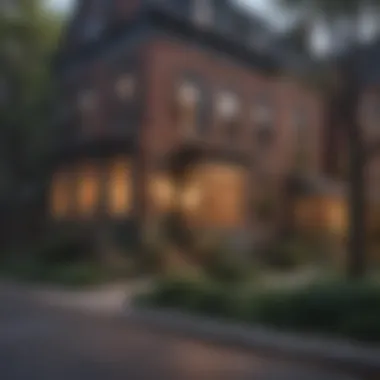Exploring Philadelphia's Best Neighborhoods to Live In


Intro
Philadelphia, known for its rich history and vibrant culture, boasts a variety of neighborhoods, each offering unique living conditions and amenities. Many factors go into choosing the right place to call home. Things like safety, community feel, accessibility, and the local housing market can affect the decision for potential residents. This guide will provide insights into Philadelphia's neighborhoods, examining aspects that can greatly influence one's living experience.
Whether one is looking for urban hustle or a serene suburban feel, Philadelphia has something for everyone. The aim of this article is to break down what these neighborhoods have to offer, from recreational opportunities to cultural significance. Having a clear picture of what each area presents will help prospective movers to make informed choices about their next home.
Home Design Inspiration
Home design can significantly elevate the living experience. It reflects personal tastes, promotes comfort, and creates an inviting atmosphere. In Philadelphia, the eclectic mix of architectural styles and interior design trends is a testament to its diverse culture.
Architectural Styles
Philadelphia’s neighborhoods showcase a rich array of architectural gems ranging from historical row homes to modern condos. The city features famous styles such as:
- Federal: Known for its symmetry, this style emphasizes brick facades and detailed cornices.
- Victorian: Colorful and ornate, these homes often have intricate woodwork and large porches.
- Art Deco: Sleek in design, Art Deco buildings feature geometric shapes and bold colors.
Each style adds a unique flavor to the neighborhood, drawing in potential residents who appreciate particular aesthetics and historical significance.
Innovative Decor Trends
Beyond architecture, interior decor trends play a key role in shaping living spaces. Current trends include:
- Minimalism: Focusing on functionality while minimizing clutter.
- Sustainability: Using eco-friendly materials and energy-efficient designs.
- Smart Homes: Incorporating technology for enhanced convenience and security.
Residents in Philadelphia often blend these trends with traditional elements, creating spaces reflective of both modernity and heritage.
Neighborhood Breakdown
As potential residents explore various areas, understanding neighborhood specifics can help them align their living choices with their desired lifestyle. Key neighborhoods, their characteristics, and amenities will be discussed in the subsequent sections, assessing factors such as community activities, housing markets, and proximity to cultural hubs.
"Exploring the nuances of each neighborhood offers vital information, guiding individuals towards making a choice that aligns with their values and lifestyle preferences."
This analysis will serve as a resource for real estate enthusiasts and individuals seeking a deeper understanding of the communities in Philadelphia. Use the insights to navigate the complex landscape of city living, ensuring a well-informed transition to a new neighborhood.
Prologue to Philadelphia's Neighborhood Diversity
Philadelphia is a city rich in culture, history, and a variety of neighborhoods. Each area offers unique characteristics, making it essential for prospective residents to understand the diverse options available. This understanding is crucial in making informed decisions about where to live, as every neighborhood can profoundly affect lifestyle, community engagement, and daily living.
Exploring Philadelphia's neighborhoods provides insights into their distinct cultures, amenities, and housing trends. Knowledge about these aspects can enhance the experience of residing in this vibrant city. It can also guide individuals and families in identifying neighborhoods that align with their needs, preferences, and goals in life.
The historical context and current dynamics of the neighborhoods play a significant role in this exploration. Neighborhoods can change over time due to various factors, such as urban development, economic changes, and demographic shifts. Recognizing these elements is essential to comprehensively evaluate potential areas for living.
In the following sections, we will delve into the historical context of Philadelphia neighborhoods, emphasizing the evolution of these areas over the years. Moreover, we will discuss the importance of selecting the right neighborhood, ensuring that future residents are well-informed while embarking on their journey to settle in Philadelphia.
Historical Context of Philadelphia Neighborhoods
Philadelphia's neighborhoods have a rich tapestry of history that is intertwined with the broader narrative of the city itself. Originating as one of the first major planned cities in the United States, Philadelphia showcases a blend of colonial, industrial, and modern influences. Many neighborhoods highlight this historical diversity, such as Old City, which dates back to the 17th century and is known for its cobblestone streets and historic architecture.
The city’s transformation through the years has also been impacted by immigration patterns. Waves of immigrants settling in different areas contributed to the fabric of neighborhoods. For instance, places like South Philadelphia hold a strong Italian heritage, while Northern Liberties reflects a more contemporary and artistic vibe.
As neighborhoods evolved, significant socioeconomic changes occurred. Some areas have thrived with upscale development and gentrification, while others have faced challenges of disinvestment and decline. Understanding this historical context allows future residents to appreciate the past and how it shapes the contemporary environment today.


Importance of Choosing the Right Neighborhood
Choosing the appropriate neighborhood is often one of the most significant decisions a person or family can make. The right choice influences various aspects of life, including social interactions, accessibility, and the overall sense of belonging.
When residents select a neighborhood, they should consider factors like community dynamics, available amenities, and compatibility with personal lifestyles. For instance, families may prioritize nearby schools and parks, while young professionals may gravitate towards vibrant areas with nightlife and networking opportunities.
Additionally, understanding the neighborhood's character and culture can affect daily experiences. Some individuals seek a bustling urban life, while others might prefer quieter, more suburban atmospheres. Each choice comes with its unique advantages and challenges, making the exploration of Philadelphia's neighborhoods essential.
Ultimately, making an informed decision about where to live requires thorough research and introspection about one’s personal needs and aspirations. Finding a neighborhood that resonates with one’s values can lead to a fulfilling and satisfying living experience in Philadelphia.
Key Factors to Consider When Selecting a Neighborhood
Selecting the right neighborhood is crucial for anyone considering a move to Philadelphia. This decision impacts not just daily life but also one's overall experience of the city. Each neighborhood has its distinctive attributes, which cater to different lifestyles and preferences. Understanding these factors can facilitate a more tailored choice that aligns with personal needs and values.
Housing Market Trends
The housing market in Philadelphia varies significantly between neighborhoods. For example, areas like Center City offer more expensive housing compared to regions like Fishtown. Homebuyers must analyze market trends including pricing, property types, and historical appreciation rates. According to recent data from the Zillow Housing Index, neighborhoods such as University City have seen stable growth due to the proximity to educational institutions. Potential buyers or renters should evaluate these trends to ensure their investment is sound and suitable for long-term residence.
Accessibility and Transportation Options
Accessibility is another vital factor when considering a neighborhood. Philadelphia has a well-connected public transportation system that includes buses, subways, and regional trains. For instance, living in areas like Manayunk provides access to the SEPTA rail, making commutes to downtown more convenient. Walkability is also important; neighborhoods like Rittenhouse Square boast numerous shops and restaurants within walking distance. Understanding the various transport alternatives available can greatly influence daily routines and lifestyle choices.
Local Amenities and Services
Local amenities play a significant role in enhancing the quality of life in any neighborhood. Access to grocery stores, healthcare facilities, schools, and parks defines the neighborhood culture and daily convenience. Areas like Chestnut Hill are noted for their abundance of green spaces and recreational activities, while Northern Liberties is famous for its vibrant dining and nightlife scenes. When evaluating neighborhoods, it is imperative to consider the proximity of essential services and recreational offerings that match personal interests and family needs.
Community Demographics and Culture
Community demographics and culture can significantly affect one’s living experience. Knowledge about the population's age, background, and interests can lead to a better fit for individuals or families. For example, enough cultural variety can be found in South Philadelphia which is rich in Italian heritage, while other areas, such as Queen Village, offer a more eclectic mix of lifestyles. Additionally, residents' involvement in local events can foster a sense of community that enhances one's connection to the neighborhood. Before relocating, consideration of the existing community dynamics can be highly beneficial for prospective residents.
"Understanding the comprehensive aspects of neighborhoods facilitates better living choices and smoother transitions into new environments."
Overall, these factors serve as a guiding framework for discerning potential residents in Philadelphia. A thorough assessment of these elements can provide deeper insights and lead to healthier, more fulfilling living arrangements.
Top Philadelphia Neighborhoods to Live In
When considering a move to Philadelphia, understanding the neighborhoods is essential. Each area has its own unique qualities, from cultural vibes to amenities and lifestyle. The neighborhoods mentioned here offer distinct environments that can shape daily living. Whether one seeks bustling urban life or a more subdued residential feel, these neighborhoods cater to various tastes and preferences. Evaluating these distinctive areas helps potential residents make informed choices tailored to their needs.
Center City
Center City is the heartbeat of Philadelphia. This downtown area provides residents with a dynamic urban lifestyle. High-rise apartments and modern condos are common and accommodate young professionals as well as families. The accessibility to public transport is a significant advantage, making commuting straightforward. The variety of restaurants, shops, and entertainment options here means residents are never far from activities.
Manayunk
Manayunk is well-known for its picturesque riverfront and vibrant arts scene. The neighborhood has a quaint charm, featuring old mill buildings and a small-town feel within the city. This area also embraces outdoor activities, with the Schuylkill River Trail offering opportunities for hiking and biking. Manayunk's local eateries are notable, often featuring farm-to-table cuisine and unique coffee shops.
University City
Home to several educational institutions, University City resonates with a youthful energy. This neighborhood is vibrant and eclectic. Residents benefit from an abundance of dining options and cultural experiences, largely influenced by the student population. The presence of parks and public spaces adds to the appeal for families and professionals. Public transport connects University City well to other parts of Philadelphia, making it a practical choice.
Rittenhouse Square


Rittenhouse Square is synonymous with affluence. This neighborhood features luxury apartments and high-end dining. The park itself serves as a central gathering spot, offering an oasis amid the urban environment. Residents enjoy a refined lifestyle characterized by boutique shopping and cultural institutions. As a prime location, it often attracts those looking for a sophisticated urban experience.
Fishtown
Fishtown has transformed into a trendy spot, appealing to younger crowds. Art galleries and music venues pop up regularly, contributing to the neighborhood's cultural landscape. The dining scene is diverse, with eateries ranging from casual to upscale. Additionally, the area retains elements of its industrial past while embracing new businesses, making it a captivating place to reside.
Queen Village
Queen Village is rich in history, showcasing charming cobblestone streets and historic homes. The neighborhood has a warm, community-focused atmosphere. Local shops and artisan markets line the streets, enhancing the sense of community. Parks are plentiful, offering places for families and pets to enjoy outdoor activities. The blend of history and modern convenience makes it an attractive option for many.
East Falls
East Falls offers a quieter, suburban feel while still being a part of Philadelphia. Its residential areas are primarily composed of single-family homes, making it appealing for families. Access to parks and the nearby Schuylkill River is a plus for nature lovers. Schools in the area are also well-regarded, adding to the neighborhood's family-friendly reputation.
Northern Liberties
Northern Liberties represents a blend of new and old Philadelphia. The area features a mix of modern developments alongside historic architecture. The neighborhood is lively and attracts a diverse crowd, known for its cultural events and nightlife. Moreover, the local parks and open spaces provide much-needed green areas amidst the urban fabric, making it a thriving place to call home.
Chestnut Hill
Chestnut Hill is often considered one of the more affluent neighborhoods in Philadelphia. Known for its beautiful homes and tree-lined streets, it has an inviting charm. The community offers boutique shopping and fine dining, catering to those looking for a luxurious lifestyle. The proximity to parks and nature preserves is attractive for many outdoor enthusiasts.
South Philadelphia
South Philadelphia is richly diverse, embodying various cultural influences. The neighborhood is well known for its vibrant Italian heritage, reflected in local markets and eateries. While the area exhibits an eclectic mix of residential options, it also offers cultural festivals and events that celebrate community spirit. The warmth of South Philly adds to its appeal, making it an engaging place to live.
Cost of Living in Philadelphia Neighborhoods
Understanding the cost of living in Philadelphia neighborhoods is crucial for those considering a move to this vibrant city. The cost of living encompasses more than just housing expenses. It includes utilities, transportation, groceries, and healthcare costs. An informed assessment of these elements helps potential residents manage their finances effectively and avoid unexpected financial strain.
Philadelphia presents a variable cost of living across its neighborhoods. Each area boasts unique characteristics that can influence expenses. For example, neighborhoods close to the city center may carry a premium for real estate due to their proximity to workplaces and amenities, while further out areas might offer more affordability.
Average Home Prices
Average home prices in Philadelphia are an essential factor influencing relocation choices. Prices vary significantly based on neighborhood demand, housing types, and available amenities.
- Center City typically showcases higher prices reflecting its status and convenience to businesses, restaurants, and cultural attractions. Median prices here often exceed $400,000.
- Fishtown has seen a notable increase in popularity and, consequently, pricing. Today's average home prices hover around $350,000.
- In contrast, areas like East Falls present more affordable options, with home prices averaging about $250,000.
These averages provide a general landscape, but they can fluctuate. Therefore, monitoring the market closely is advisable. Potential buyers often look for neighborhood trends that indicate rising or stabilizing prices.
Rental Market Overview
The rental market in Philadelphia also deserves attention. It is shaped by various factors, including location, property type, and overall availability.
- Center City commands premium rental prices, with one-bedroom units frequently rented for over $2,000 per month.
- In neighborhoods like Queen Village, renters can find units around $1,900, while Manayunk offers a more accessible range, with averages closer to $1,600.
A critical aspect of the rental market is the lease terms and associated costs. Many landlords require first month’s rent, last month’s rent, and a security deposit, which can add up. Additionally, fluctuating rental prices can challenge new residents. It's wise to consult local listings regularly and consider using rental services for better insights.
Understanding these elements in both home prices and rental agreements will guide future residents in making well-informed decisions.
Stay aware of your budget, but also consider factors like neighborhood culture and amenities.


An informed choice requires balancing both financial feasibility and personal preferences.
Safety and Crime Statistics
Understanding safety and crime statistics is essential when considering a neighborhood. Data on crime rates not only reflects the safety of an area but also influences property values and the overall quality of life. For those looking to move to Philadelphia, knowing about crime statistics can help in making informed decisions. Neighborhood safety impacts daily living, comfort, and the community's reputation.
Safety statistics allow potential residents to gauge the relative security of various neighborhoods. They can highlight hot spots for criminal activity and areas that offer a safer environment for families and individuals alike. A deeper look into these statistics can also reveal trending patterns which can inform about improvements or deteriorations in safety over time.
Moreover, understanding crime data can lead to a greater appreciation for community initiatives aimed at reducing crime rates. This aspect is crucial because it indicates the level of community involvement and resources dedicated to maintaining peace and security.
A careful assessment of safety statistics thus serves multiple purposes. It helps determine if the neighborhood aligns with personal values and lifestyle preferences, increasing the likelihood of a satisfactory living experience.
Crime Rates by Neighborhood
Philadelphia's neighborhoods experience varying crime rates, which can be understood better through careful analysis. In Center City, for example, crime rates tend to be lower due to high foot traffic and active law enforcement presence. In contrast, areas like South Philadelphia often report higher levels of certain crimes, which requires a different evaluation from potential residents.
Here's a brief overview of crime perspectives by prominent neighborhoods:
- Center City: Low overall crime; primarily property-related incidents.
- Fishtown: Moderate crime with an increase in property and drug-related reports.
- South Philadelphia: Higher crime rates, particularly in specific pockets.
- University City: Crime typically reflects the student population, with frequent petty thefts.
It is crucial for individuals to do thorough research as these statistics change over time, influenced by numerous factors such as local initiatives and economic variables.
Community Safety Initiatives
Many neighborhoods engage in safety initiatives aimed at fostering secure environments. Community involvement plays a vital role in crime reduction. Programs such as neighborhood watch groups, community policing, and local awareness campaigns reflect a commitment to safety and enhance the quality of life. For instance, Northern Liberties hosts various programs that encourage resident participation in neighborhood watch efforts.
Additionally, technology plays a crucial role in modern safety initiatives. Surveillance cameras installed in high-traffic areas aim to deter crime and provide law enforcement with valuable data. Efforts in University City include partnerships between residents and the university, ensuring the safety of students and faculty.
Other notable community-led safety initiatives include:
- Regular town hall meetings to discuss safety concerns.
- Online forums where residents share information about suspicious activity.
- Collaboration with local authorities for a proactive approach to crime prevention.
These initiatives not only help in reducing crime but also enhance the sense of community among residents, making neighborhoods more inviting. In summary, crime rates and community safety initiatives should be taken into serious consideration when deciding on a place to live in Philadelphia.
Epilogue: Making an Informed Decision
Understanding the neighborhoods of Philadelphia is critical for anyone considering relocation. It is not merely about picking a spot to live; it involves choosing an environment that aligns with personal and family needs. Each neighborhood offers distinct characteristics that influence life quality, community engagement, and accessibility to amenities. Therefore, making an informed decision encompasses several layers of evaluation, centered on personal priorities and practical considerations.
Reflecting on Personal Priorities
When contemplating a move, it's essential to reflect on your own values and priorities. This process begins by identifying what aspects of life are most important to you. Some may prioritize neighborhood safety, while others could emphasize proximity to work or educational institutions.
Here are some factors to consider:
- Lifestyle Preferences: Are you seeking a lively urban environment or a quieter suburb?
- Family Needs: If you have children, proximity to schools and parks may be essential.
- Cultural Fit: Consider how well a community's demographics and culture align with your lifestyle.
- Commute and Transportation: Evaluate how commuting times affect daily life and stress levels.
Taking the time to assess what matters most will help filter out neighborhoods that do not meet your criteria. This will narrow down the options to areas that genuinely enhance your well-being and fulfillment.
Taking Action: Next Steps for Relocation
After establishing your priorities, the next step is action. Transitioning to a new neighborhood can feel overwhelming, but a structured approach can ease this process. Start with research and immerse yourself in the community. Here are steps to consider:
- Visit Potential Neighborhoods: Spend time walking through the streets, visiting local shops, and introducing yourself to residents.
- Connect with Local Resources: Use LinkedIn or community forums on platforms like Reddit to gather insights from current residents.
- Evaluate Housing Options: Decide whether to rent or buy, based on your financial plans and housing market trends.
- Engage Local Communities: Join local groups on Facebook or community boards to understand ongoing initiatives and events.
- Consult Real Estate Agents: Seek professional advice to navigate the real estate complexities in your chosen area.
"Relocation should not be a mere change of address, but a calculated step towards improving one's quality of life."
In summary, making an informed decision regarding relocation in Philadelphia contributes significantly to long-term happiness. By reflecting on personal priorities and executing a structured approach to the move, anyone can find a neighborhood that not only meets their needs but also enriches their everyday lives.







